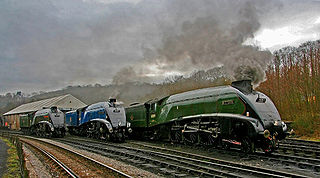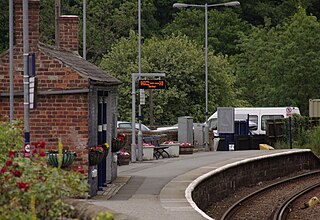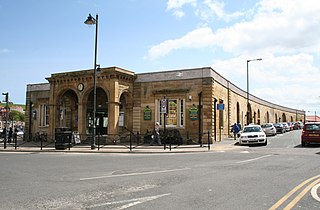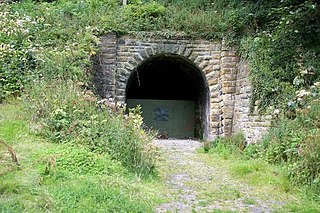
The North Yorkshire Moors Railway (NYMR) is a heritage railway in North Yorkshire, England, that runs through the North York Moors National Park. First opened in 1836 as the Whitby and Pickering Railway, the railway was planned in 1831 by George Stephenson as a means of opening up trade routes inland from the then important seaport of Whitby. The line between Grosmont and Rillington was closed in 1965 and the section between Grosmont and Pickering was reopened in 1973 by the North York Moors Historical Railway Trust Ltd. The preserved line is now a tourist attraction and has been awarded several industry accolades.

Malton railway station is a Grade II listed station which serves the towns of Malton and Norton-on-Derwent in North Yorkshire, England. Situated on the York-Scarborough Line, it is operated by TransPennine Express, who provide all passenger train services.

Grosmont is a railway station on the Esk Valley Line, which runs between Middlesbrough and Whitby via Nunthorpe. The station, situated 6 miles 24 chains (10.1 km) west of Whitby, serves the village of Grosmont, in the Borough of Scarborough, North Yorkshire, England. It is owned by Network Rail and managed by Northern Trains. The station is also served by heritage services operated by the North Yorkshire Moors Railway.

Sleights is a railway station on the Esk Valley Line, which runs between Middlesbrough and Whitby via Nunthorpe. The station, situated 2 miles 78 chains (4.8 km) south-west of Whitby, serves the villages of Briggswath and Sleights, Scarborough in North Yorkshire, England. It is owned by Network Rail and managed by Northern Trains.

Whitby is a railway station serving the town of Whitby in North Yorkshire, England. It is the southern terminus of the Esk Valley Line from Middlesbrough. The station is owned by Network Rail and services operated by Northern Trains for mainline services and the North Yorkshire Moors Railway for heritage services.

Levisham railway station is a station on the North Yorkshire Moors Railway and serves the village of Levisham in the North York Moors National Park, North Yorkshire, England.

Newton Dale Halt railway station is a request stop on the North Yorkshire Moors Railway and serves as a stopping off point for walkers around Newton Dale and Cropton Forest in the North York Moors National Park, North Yorkshire, England. When the station was opened, the station signs were written as Newtondale Halt.

Goathland railway station is a station on the North Yorkshire Moors Railway and serves the village of Goathland in the North York Moors National Park, North Yorkshire, England. It has also been used in numerous television and film productions. Holiday accommodation is available in the form of a camping coach.

Rillington railway station was a railway station serving the village of Rillington in North Yorkshire, England and on the York to Scarborough Line. It was also the junction station for the line to Whitby and was opened on 5 July 1845 by the York and North Midland Railway. It closed to normal passenger traffic on 22 September 1930, but was used by special trains until the 1960s. The goods yard was closed on 10 August 1964. The station building has been converted to a private house but the remainder of the station has now been demolished.

The York and North Midland Railway (Y&NMR) was an English railway company that opened in 1839 connecting York with the Leeds and Selby Railway, and in 1840 extended this line to meet the North Midland Railway at Normanton near Leeds. Its first chairman was the railway financier George Hudson, who had been called the railway king.

The Whitby, Redcar and Middlesbrough Union Railway (WRMU), a.k.a. the Whitby–Loftus Line, was a railway line in North Yorkshire, England, built between 1871 and 1886, running from Loftus on the Yorkshire coast to the Esk at Whitby, and connecting Middlesbrough to Whitby along the coast.
George Townsend Andrews was an English architect born in Exeter. He is noted for his buildings designed for George Hudson's railways, especially the York and North Midland Railway. Andrews' architect's practice in York did not confine itself to railway work, its other buildings including headquarters for two York-based banks and a number of churches.
The North Eastern Locomotive Preservation Group (NELPG) was formed in 1966 with the intention of preserving some of the steam locomotives then still working on regular goods or passenger trains in North East England. At the time of its formation, its first president was Wilbert Awdry, the author of The Railway Series books and the creator of Thomas the Tank Engine. Now the group owns four unique North Eastern steam locomotives, its aim is to have as many of its steam locomotives running on the main line or preserved lines as possible. In 2014, the LNER K1 (62005) ran on the North Yorkshire Moors Railway and on the Jacobite service in Scotland. The LNER Q6 was undergoing boiler repairs at the start of the season but finished the season on the North Yorkshire Moors Railway and the LNER J72 ran on the Wensleydale Railway. The group have two workshops, one at Hopetown Carriage Works, Darlington and another workshop and base at Grosmont, the northernmost station on the North Yorkshire Moors Railway. The shed at Grosmont is called deviation shed. Members of the group hold regular evening meetings to discuss railway subjects, have a membership newsletter, and have produced various publications. The group now also has a junior volunteers section, training young recruits at, mainly, the NYMR and Deviation Shed. These JVs will help with mainly the locomotives, although a small amount has been done on the carriages.

The Whitby and Pickering Railway (W&P) was built to halt the gradual decline of the port of Whitby on the east coast of England. Its basic industries—whaling and shipbuilding—had been in decline and it was believed that opening transport links inland would help regenerate the town and port.

Beckhole railway station was a railway station at Beck Hole in the North Yorkshire Moors on part of the original Whitby and Pickering Railway line. Although it was possible to travel to Beckhole in 1835, the station was opened in 1836, and closed to passengers permanently in 1914. Beckhole closed completely in 1951.

Goathland Bank Top was a short lived, early, railway station in Goathland, North Yorkshire, England. The station at the top of the Beckhole Incline was opened with the opening throughout of the Whitby and Pickering Railway (W&P) on Thursday 26 May 1836. The station closed with the opening of the NER's Deviation line on 1 July 1865. Thus the station had a life of less than thirty years. A new Goathland station was opened on the deviation line.

The Grosmont Tunnels are two separate railway tunnels adjoining each other in the village of Grosmont, North Yorkshire, England. The first tunnel was built in 1835 and has now become a pedestrian route through to the North York Moors Railway (NYMR) engine sheds on the south side of the hill.

Potto railway station was a railway station built just north of the village of Potto in North Yorkshire, England. The station was on the North Yorkshire and Cleveland's railway line between Picton and Stokesley. The line was extended progressively until it met the Whitby and Pickering Line at Grosmont. Potto station was closed in 1954 to passengers and four years later to goods.

Whitby engine shed was a steam locomotive depot located at the south end of Whitby railway station in North Yorkshire, England. The shed was opened in 1847, extended in the 1860s, and closed in 1959, when the closure of lines and dieselisation of the routes from Whitby took hold. The shed building, which was grade II listed in 1991, still stands, being utilised for various enterprises, and is now used as holiday accommodation.

Beckhole Incline was a steep, rope-worked gradient on the railway line between Whitby and Pickering, in the North Riding of Yorkshire, England. Opened in May 1836 as part of the horse-worked Whitby & Pickering Railway, the line was operated by three railway companies before becoming redundant on the opening of a diversionary line to the east that allowed through working by steam engines on the entire line. Although the incline was closed to regular traffic in 1865, it was used for a very brief period in 1872, to test a special locomotive intended for railways with steep gradients.





















